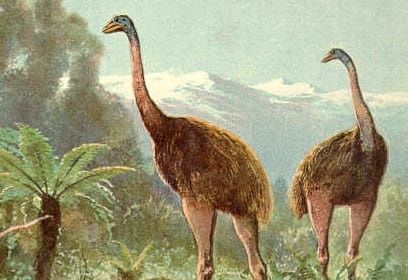Up to 2.5 million moa may have once roamed the country, researchers have calculated.

Detail of an illustration of two moa. Photo: Wikipedia / Heinrich Harder
Landcare Research worked out what the mean national density of moa might have been a thousand years ago, before humans arrived.
Their findings have been published in the journal Ecography.
One of the report's authors, Dave Latham, said they were able to work it out by first compiling a global data set of body masses and population densities for living flightless birds.
"In general, the heavier an animal species is, the lower its population density (the numbers of a species that can be supported in an area of land)," he said.
"This is because larger animals need more energy resources (food/water) to survive. This relationship is strong for living species of flightless birds and therefore it can be used to estimate densities of extinct species of flightless birds."
The authors applied this approach to each of the nine species of moa.
The mean national density was between two and 10 birds per square kilometre, giving a total estimated population of between half a million and two and a half million birds.
"These estimates reconcile previous population density estimates for moa, which have been either quite low (fewer than two per square km) or high (more than 10 per square km)," Dr Latham said.
The researchers hope that the refined model can also allow improved population density estimates for other large prehistoric flightless birds around the world, such as the elephant birds from Madagascar, the Mauritian dodo, or the Hawaiian moa-nalos.

